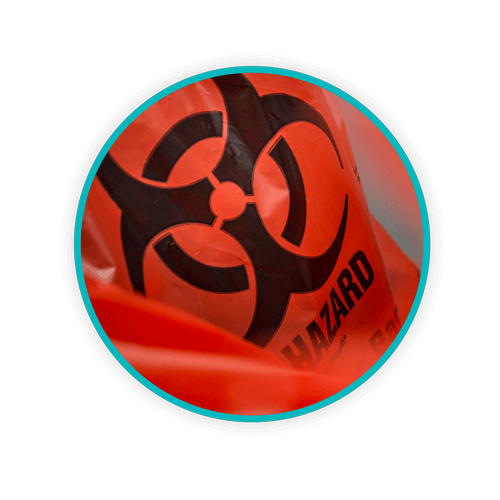910 Bed Virginia Hospital
The Challenge
With over 1 million pounds of medical waste generated annually, this 910 bed facility required a large-scale solution for red bag waste storage in between service/pickups. The facility was generating over 2lbs / adjusted patient day, (nearly double the Practice Greenhealth recommended amount of 1lb for a facility of this size). The incumbent vendor’s solution for this was a one-size-fits-all, mass disposal container known as a Red Bag Express (RBX Container) or medical waste roll-off. The approximate dimensions of a 40-yard dumpster are 20' X 8' X 8', requiring at minimum the space of an entire dock bay.
The biggest challenges at this facility were labor requirements of regulated medical waste movement and high medical waste volumes. The hospital was looking to bring a simplified solution for red bag waste disposal that would decrease EVS labor requirements and cross-contamination risks, while enhancing dock storage, operations, safety, and compliance. The hospital sought to bring a simplified solution to their waste management plan. This customer, like many hospitals in similar positions, was simply not aware that a better solution existed.
Our Approach
STEP 1
Waste Assessment & Dock Analysis
The Daniels team conducted a full site assessment and dock analysis to identify the locations of each red kick bucket in patient areas as well as locations where larger biohazard bins were housed. We shadowed nurses to observe their process of generating the waste and then also shadowed EVS to watch their current process of collection to identify the number of touches and probability of risk while moving the waste. We were able to estimate the time it took to service each department and identify inefficiencies in the current process.
STEP 2
Re-Mapped Movement of Medical Waste Through Facility & Removed RBX Container
Next, we presented a plan to educate on medical waste movement. We introduced mobile 96 Gallon RMW totes in soiled utility rooms and removed kick buckets from the facility. We presented a plan to more efficiently move medical waste bins without pulling bags and without having to pull every bin, but instead only pulling full medical waste bins; thus eliminating bag related injuries and spills while also giving valuable time back to hospital staff. We introduced the replacement of 2 RBX containers and catwalks with the Daniels trailer, freeing up an entire dock bay. Once the clinical and EVS teams were on board, we were able to present our waste reduction goals on top of competitive pricing to the purchasing team. Once we were chosen, the real work began.
The EVS department was most impacted by this transition. Our operational and clinical education team worked with the facility's EVS department to design a solution that would remove the RBX container and transform RMW waste movement throughout the site. At the dock, the RBX container was replaced with a 53-foot Daniels trailer. The Daniels trailer allows for soiled bins full of red bag waste to be wheeled directly onto the trailer and stacked into two rows. This eliminated the use of 200 gallon red mobile carts, EVS labor requirements, 24-hour dock master position, and reduced required touches by 75%.
STEP 3
Red Bag Waste Reduction Initiatives
Daniels clinical education team performed a comprehensive audit throughout the facility to identify right-sizing opportunities, segregation issues (i.e., wrappers & coffee cups in kick buckets), and areas where kick buckets could be removed. A major factor of this was the placement of red bag containers in med rooms. Current practice had municipal solid waste containers placed next to red bag waste containers, thus creating opportunities for inappropriate segregation by both patients and staff. Daniels' improved approach was to place a large trash can by the patient room door with the smaller red bag waste container on the other side of the room, to afford easy disposal for municipal solid waste (MSW) and discourage solid waste from going into the RMW container.
The Solution
- Introduced mobile 96 Gallon RMW totes in soiled utility rooms and removed kick buckets wherever possible
- Removed red bags and eliminated liners entirely
- Re-mapped containers throughout facility to encourage segregation
- Implemented education posters throughout facility
- Removed 2 RBX containers from dock and replaced with Daniels double-stack trailer for soiled containers
- Removed all 200 gallon red mobile carts and dismantled cat walk in dock area
The Outcome
In summary, the transition from the incumbent’s RBX containers to Daniels' re-imagined red bag waste solution has brought a drastic transformation to dock operations. While initially hesitant to make the change, both EVS staff and C-Suite Leadership has expressed nothing but positive feedback. With the introduction of mobile 96 gallon bins and the Daniels trailer, the facility achieved the following outcomes:
- Required touches for red bag waste movement reduced by up to 75%
- Reduced medical waste volumes by 15%
- Reduced overall labor requirements by >30 minutes per FTE per shift
- EVS staff is no longer required to pull individual bags
- Safety and cross-contamination risks of hauling bags throughout facility resolved
-
Removal of 35 200-gallon red mobile carts no longer taking up valuable storage space

- Streamlined dock organization
- Removed unsightly and odorous RBX dumpsters
- Transitioned two external 24-hour FTE dock masters, solely responsible for overseeing the dock master, to full-time internal EVS employees.
- Pick up schedule reduced: initially scoped at five days a week; down to three days a week
